What are sneaker raffles, how do they work & why do retailers use them?

Raffles are a mainstay of the sneaker world. Every week, hundreds of thousands of sneakerheads enter raffles hoping to cop a hyped pair of shoes. Discover everything you need to know about sneaker raffles, including how they work, why companies use them, and the alternatives to shoe raffles major brands leverage. Plus, learn how Nike, adidas, New Balance, and Foot Locker run their hyped drops.
Table of Contents
A sneaker raffle is a way to sell popular sneakers using the fairness of randomization. Customers register their interest in a pair of sneakers, then a company select winners at random and gives them the chance to buy the shoes.
You’ve probably taken part in raffles at school events, your local bar, or your community center. In these raffles, you pay, say, $2 for a chance to win some prize worth more than $2—a gift basket, nice bottle of wine, or some merchandise.
Sneaker raffles, or shoe raffles, are essentially the same (although they’re mostly free to enter). They’re designed to give every customer a fair and equal chance at copping a pair of hyped sneakers.
Sneaker raffles come in two key forms:
- The online sneaker raffle: raffles for sneakers that take place on ecommerce sites. These raffles usually require customers to provide contact, delivery, and payment information ahead of time, then winners have the cost automatically deducted from their accounts and the sneakers shipped to them.
- The in-store sneaker raffle: raffles for sneakers that take place in-store. These raffles might ask for a name or phone number, then winners are contacted and asked to come to the store to pick up and pay for their sneakers.
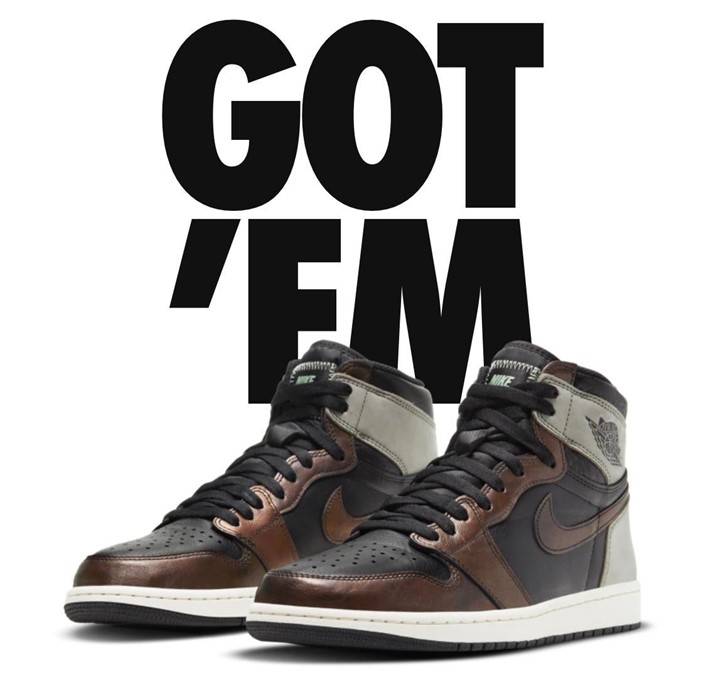
Sneaker raffles work by a retailer opening a time window during which customers can sign up for the raffle. This could be 10 minutes, a day, or a week. When this time window closes, the company gathers the pool of customers who entered and randomly selects the entries that win.
Different companies run raffles in different ways. Many retailers consider a raffle entry a kind of pre-purchase. This means when you enter the sneaker raffle, you must include your sizing, shipping, and payment details. If you’re selected, the cost of the shoes is automatically deducted from your account and the sneakers are posted to you.
Other retailers simply reserve the shoes for raffle winners. After they determine you’ve won, they’ll let you know you’ve been selected, then say you have an x-minute window to make your purchase or pick them up from the store. If you don’t purchase the sneakers in the allotted time, the shoes go to the next selected customer.
Some sneaker brands have their raffles open for weeks. Others, such as Nike, have a 10-minute window where you can enter their raffles.
While most raffles use total randomization, some brands and retailers take a slightly different approach.
Foot Locker, for instance, allows you to use loyalty points to make additional entries to increase your odds.
Nike also rewards loyalty in its raffles. On especially hyped drops, their selection process favors customers who’ve entered and lost previous raffles.
RELATED: How SNIPES Manages Massive Traffic for Hyped Sneaker Drops

Sneaker raffles emerged out of necessity. And while they pre-date online sales, they’ve become just as important for online retailers as they were for brick-and-mortar retailers.
We have drop culture to thank for sneaker raffles.
Drop culture is the movement towards brands releasing limited-edition products in small quantities at an exact time. This is where the term "sneaker drop" comes from and the sales strategy it describes.
In the late 1990s and early 2000s, drop culture emerged in full force, and sneaker brands were alongside streetwear brands leading the charge. This product drop phenomenon took advantage of the urgency and hype created by scarcity marketing to inspire a culture that turned sneakers into hot-ticket items and a form of social capital.
RELATED: Everything You Need to Know About Product Drops: Strategies, Benefits & Examples
Limited-edition sneaker drops drew giant queues. People camped overnight outside stores. Fights and riots started over shoes. Neighbors and police hated their local sneaker store for the noise, crowds, and sometimes even violence hyped drops caused.

In this context, businesses needed a solution to avoid these overnight queues and the issues they were causing for customers, local communities, and police.
Enter raffles.
By using raffles, sneaker stores removed the competition over who could get in line first and how long individuals were willing to camp out.
Everyone gets an entry. And the entries are randomized, so everyone gets a fair chance.
Now, you’d think that as sneaker drops moved online, the need for raffles would disappear, right? People can’t camp out overnight and get into fights on a website.
But the ecommerce shift presented new challenges for raffle sneaker drops. And before long, major brands were running shoe raffles online, just as they'd done in stores.
RELATED: 5 Issues with Online Sneaker Raffles: Bots, Transparency & Hype
Why do companies still run sneaker raffles online?
Companies still run sneaker raffles online because high demand always causes issues—even online.
As sneaker drops moved online, the issues faced in the early 2000s—violence, queues, scalpers—emerged in new forms.
Instead of being shut down by police because of fights and noise complaints, online sneaker drops were being ruined by levels of traffic sites couldn’t handle. The sometimes hundreds of thousands of customers that tried to access hyped product drops crashed major sites from Nike to adidas to Foot Locker.
Instead of dedicated scalpers camping out all night to purchase products to for resale, sophisticated developers used shopping bots to snatch up inventory.
Sneaker brands returned to the shoe raffle model because it helped them tackle: (a) the sudden traffic peaks caused by sneaker drops, and (b) the problem of bots clearing out inventory before genuine customers could purchase.
But online raffles didn’t solve everything. While most sneaker brands still run raffles for particularly popular sneakers, they avoid raffles in many cases for a few key reasons.
These include:
- Raffle bots making raffles unfair
- The lack of transparency with raffles
- Lower hype around sneaker raffles than traditional drops
- The need for third-party raffle solution providers
Do you have a bot problem? Get your free guide to uncover the risks of bots & discover how you can beat them

Sneaker raffles help solve a couple key issues. But they also create several new ones.
So, where does that leave sneaker brands and retailers?
Most major brands are shifting to a hybrid drop model. Today retailers typically have a repertoire of different mechanisms they draw upon for different situations.
This includes raffles, invite-only drops, “live raffles”, virtual queues, and the traditional, first-come, first-served (FCFS) sale.
Many smaller sneaker retailers take this varied approach to drops. A Few Store, Bodega, and 43einhalb sneakers, for example, all launch regular sneakers FCFS, but run raffles for their biggest drops.
Let’s take a quick look at some of the key sales methods used by the sneaker world’s biggest players.
RELATED: Why Major Sneaker Retailers Are Running "Live Raffles" For High Heat Sneaker Drops
Adidas’ hyped drops are exclusively available to members on the CONFIRMED app. On the app, adidas uses 3 different release mechanics in addition to the traditional first-come, first-served approach for non-hyped sneakers. These are:
- The draw: A sneaker raffle
- The invite: A sneaker drop only available to people adidas chooses to invite
- The queue: An online, FCFS queue (or virtual waiting room) used to tackle high demand and detect bots
It’s unclear how exactly adidas chooses between these three mechanisms, but they say it “depends on the demand, availability, strategy and distribution of a drop.”
Each of the mechanics are “customized to offer the best approach for each drop, using a mix of technical elements that allow us to assess demand, verify information and ease traffic load on our app.”
RELATED: What is a Virtual Waiting Room?
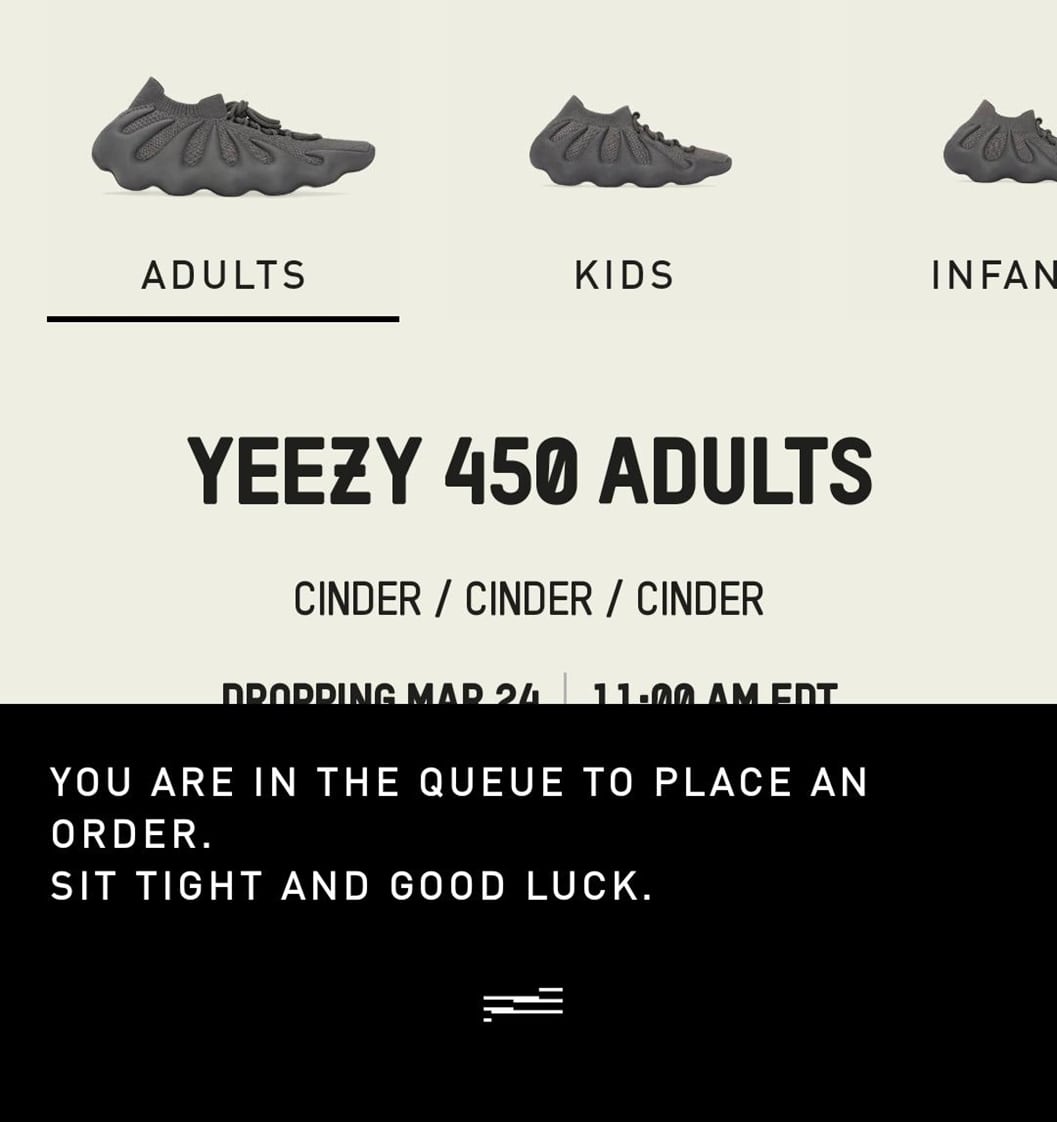
Nike does something similar to adidas for their drops. They have different drop mechanisms and make their drops exclusively available on the SNKRS app, to make it more difficult for bots to exploit.
Nike uses a mix of FCFS sales and raffles (or “Draws” as they call them) for their drops.
So how do Nike raffles work? Nike's raffles have a very limited window for entry, typically between 2 and 15 minutes, where they don't use a virtual waiting room. When the raffle opens, customers rush to the Nike SNKRs app to enter the draw. Just minutes after the entry window closes, customers get notified if they've been selected.
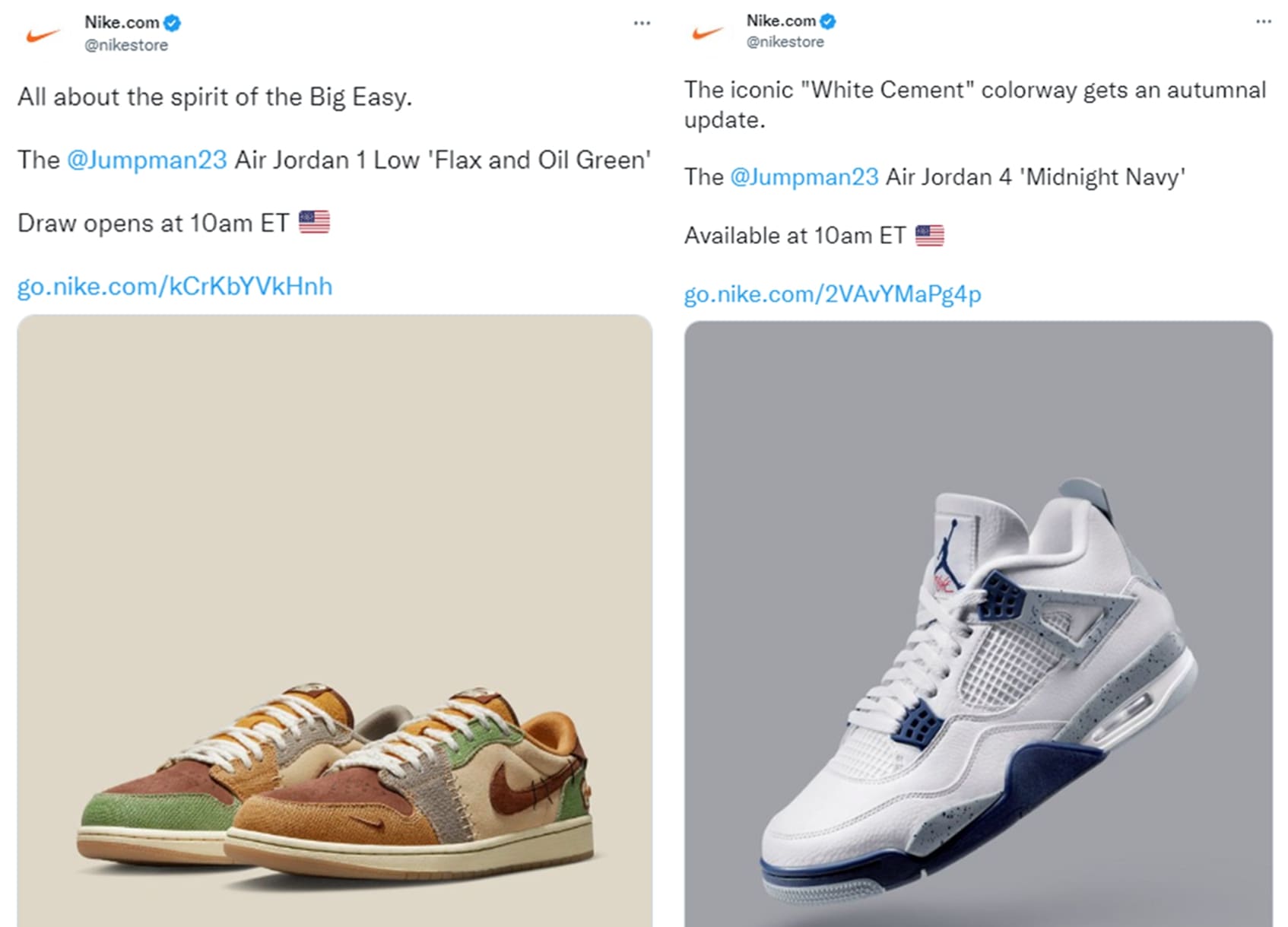
While these “quick draws” generate hype, they also create a massive amount of traffic, from genuine customers and bots alike. Without a queuing system, these high heat drops often cause technical issues. In a recent sale, for example, the “join” button was reportedly unavailable to a wide subset of customers.
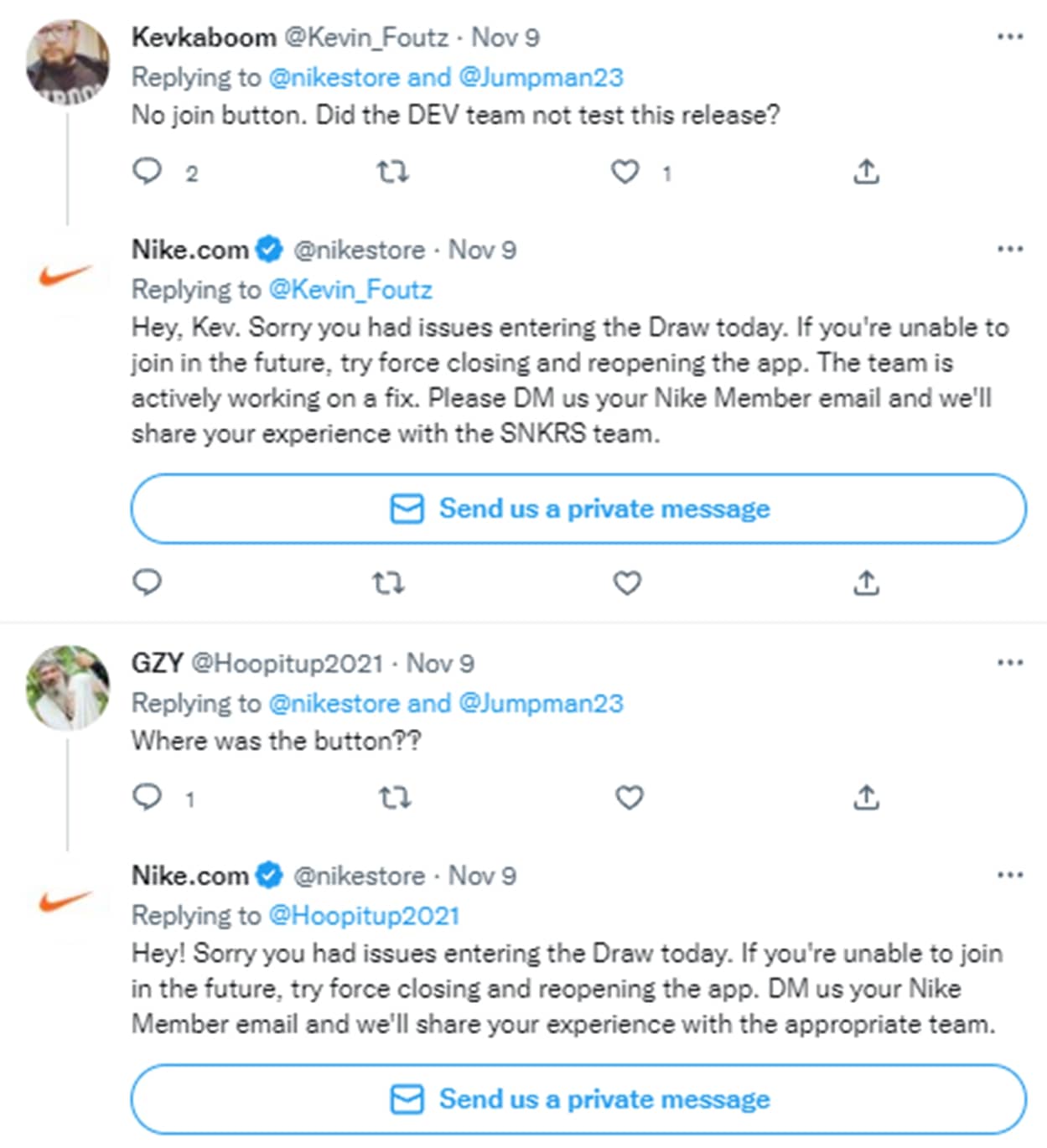
In addition to their quick draws, Nike uses an exclusive access system that gives exclusive product availability to customers who continually miss out.
RELATED: Reward Loyal Customers with Exclusive Invite-only Sales & Drops
Nike CEO John Donahoe explains: “This approach sends personalized purchase offers to members based on their engagement with SNKRS, past purchase attempts, and other criteria, using data science to drive digital member targeting. For example, 90 percent of the invites for the Off-White Dunk went to members who had lost out on a prior Off-White collaboration over the past two years.”
This strategy involves a different approach to fairness. Nike adapts their definition of fairness to give back to loyal customers who are failed by randomization.
RELATED: Customer Loyalty in Ecommerce: The Surprising Benefits of Fairness
For hyped sneakers, New Balance runs drops using a virtual waiting room and “live raffle” mechanism.
Before the sale, customers gather on a branded page with a countdown timer. When the timer hits zero, they’re randomized, just like a raffle, and given a position in queue.
Customers then proceed to the product page in their randomly assigned order. And customers who arrive after the start of the sale are put at the back of the queue.
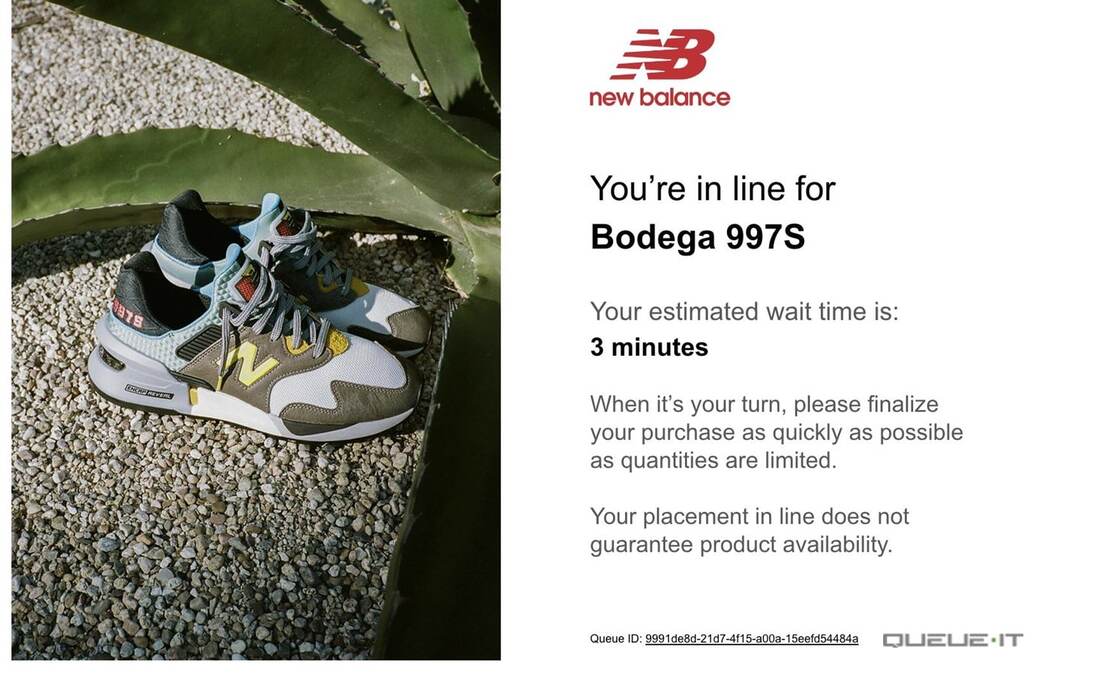
This system is like a raffle without entries, since it uses randomization, but does so instantaneously. Instead of being randomly selected to purchase the shoes, customers are randomly selected to get access to the product page.
Filtering traffic through a waiting room allows New Balance to deal with the huge traffic spikes while still generating the desired hype and social media chatter around releases. Plus, slowing users into a queue allows New Balance to identify and remove bots from the sale.

Foot Locker uses the same “live raffle” waiting room release mechanism as New Balance, as well as traditional raffles and FCFS drops.
Like Nike and adidas, Foot Locker’s most hyped drops are only available to registered Foot Locker members.
Foot Locker’s raffles aren’t always completely random. They allow customers to build up loyalty points by shopping with Foot Locker. Then, during hyped drops, these loyalty points can be used as “Head Starts”, which when used increase the customer’s odds of winning.
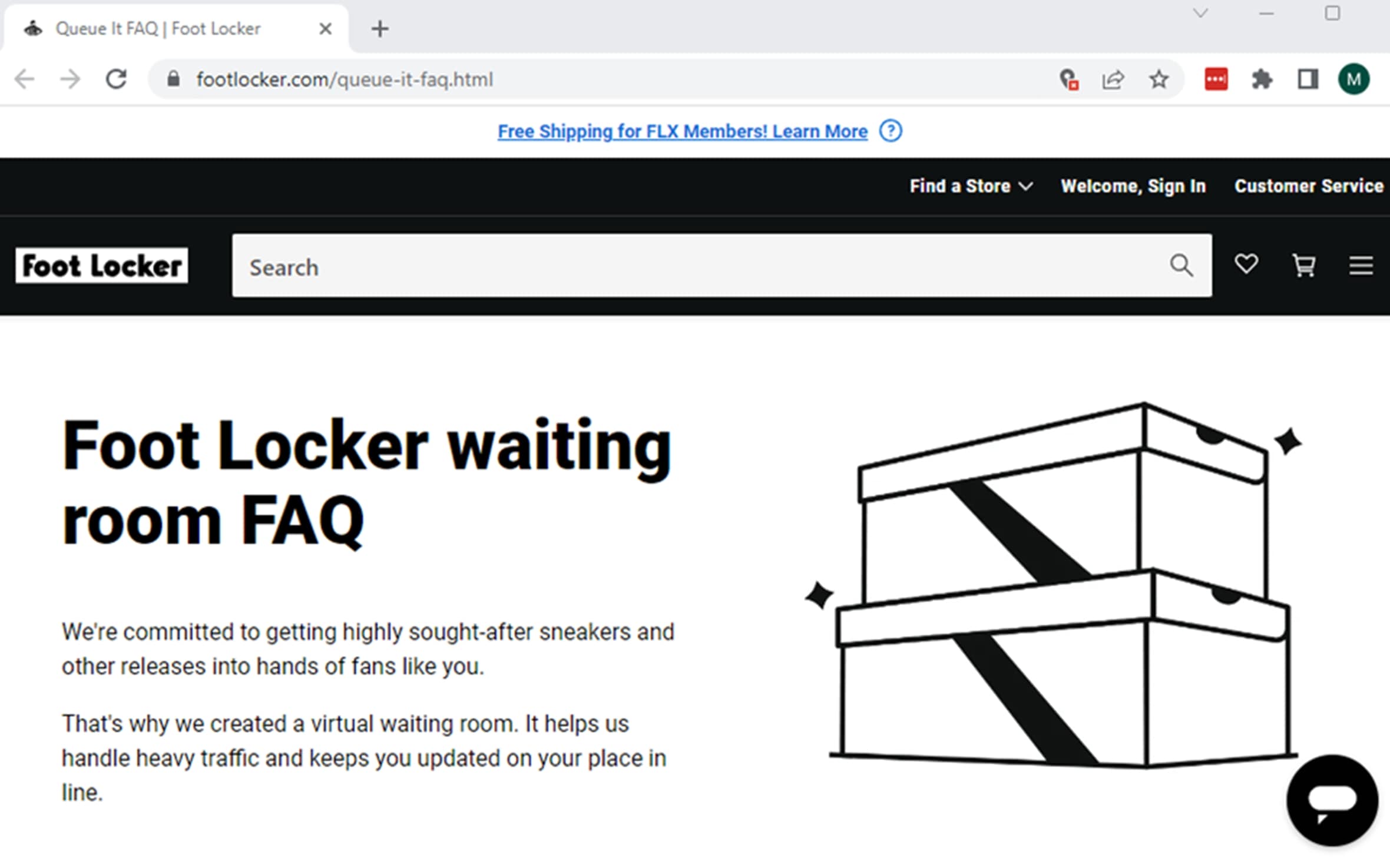
Getting a hyped pair of sneakers at retail price is more difficult than ever.
Bots swarm every major drop.
Raffle entries for major brands are in the millions.
And there’s hundreds of Twitter accounts, Instagram accounts, and Discord channels set up specifically to notify people when and where they can cop drops and restocks.
Your best bet for winning on sneaker drops is understanding the release mechanisms retailers use and adjusting your approach to match.
For raffles, enter as many different ones as you can. But don't submit multiple entries for the same raffle—major brands have sophisticated systems for weeding out people who don't play by the rules, so you'll risk losing your chance altogether. Ensure you know when the raffle opens and you make your entry in the allotted time. Look to your local sneaker store for in-store raffles, as these usually have better odds.
For first-come, first-served drops, ensure you’re on the product page before the drop goes live. If the drop is scheduled for 10 a.m., refresh the page exactly at that moment. Make sure you’re logged in and have your personal and payment information pre-filled.
For live raffles, make sure you arrive before the randomization process. If you arrive at a time after the drop is scheduled for, you’ll be placed at the back of the line, rather than benefiting from the fairness of randomization.